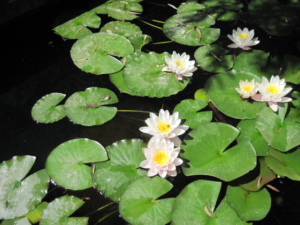
Water Lilies
Photograph by Nancy E. Rogers
Wishful Thinking
The pond was teeming with a wide variety of wildlife and vegetation that lived in and around it. Ruwena [masquerading as an H. sapiens] longed to dive into the pond and swim around in it – just not as a human. Alas, the vegetation around the pond would not provide sufficient cover for a river otter. An otter would be too large and readily spotted, and the people in the compound were vigilant. On the other hand, waterlilies were rooted in the mud beneath the pond. The pond also had elodea, a common aquatic plant that stayed submerged. Perhaps, if I stayed submerged, Ruwena wondered. Except for her nose from time to time, she could swim in the pond and hide among the elodea and waterlilies. But the moment she stuck her head above water, she would stand out like a sore thumb. Perhaps, if I swim at night, she thought. Unfortunately, an aquatic mammal cannot fly out a dormitory window, so this would require multiple transformations. Then, there are the faculty and scouts who patrol the compound at night. Their alternate species were nocturnal mammals with excellent night vision. If they espied a river otter in their pond one night, they would insist on learning how it got there. (Excerpt from Homo transformans: The Origin and Nature of the Species.)
Water Lilies
The water lilies in the photograph above are characteristic of the variety that can be found in many ponds. The size of their leaves can vary with the species. The American white water lily can have leaves as large as 10 inches. When a pond is densely populated with water lilies, their flat leaves provide cover for fish and other wildlife that swim there – even a river otter.
River Otters
A female adult North American river otter is about 2 feet long and weighs about 10 pounds. Depending upon the depth of the pond, such a slender animal might be able to swim underwater without disturbing the water’s surface. A river otter’s nostrils, poking just above the water line, could easily be missed. Yet, river otters like to frolic, and this activity would not go unnoticed.
Orig. 6 September 2019
Rev. 26 September 2019
Send comments to Mary Elizabeth at Haleth22@aol.com or use the Contact Mary Elizabeth box below.